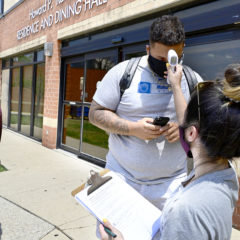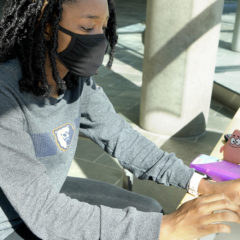This past summer, David K. Wilson, Ed.D., hoped to commemorate the 10th year of his presidency of Morgan State University (MSU), reflecting upon a succession of achievements that had elevated Maryland’s largest Historically Black College or University (HBCU). It was the start of a new fiscal year, and the moment was ripe for a new beginning heralding the future being built on the foundation of a new strategic plan.
This milestone anniversary signaled a pivotal point in his career, one worthy of celebration. The moment, however, would be tempered by one of the biggest challenges of his presidency to-date: overcoming an unseen global menace threatening to undermine the whole of higher education as we knew it. Seven months earlier, Dr. Wilson and the world were introduced to the novel coronavirus that causes COVID-19, and because of this highly transmittable disease, life at the University was completely disrupted, leaving most of the campus deserted since March. The University was at a precipice, but it had been here before.
In 2010, the higher education community was wrestling with budget problems that required tuition and fee increases and was making collective efforts to increase graduation rates. Colleges and universities were dealing with a number of external factors that directly and indirectly impacted operations, namely: a struggling national economy, major reductions in state appropriations, high unemployment rates, issues surrounding race and racial bias, and a swine flu (H1N1) pandemic.
During this same period, a first-class postage stamp was 44 cents, Apple had just released its first-generation iPad tablet computer, and Barack Obama was two years into his first term as our nation’s 44th president. Hope and change seemed to permeate the country, and Morgan was not excluded. Dr. Wilson, a self-proclaimed “newcomer” to Baltimore, was hired to take the helm, and so began the tenure of the University’s 10th inaugurated president, an HBCU-birthed, Ivy League-educated optimist, whose worldly experiences spurred him to think bigger than the moment. In retrospect, it seems almost fitting that Dr. Wilson’s first 10 years on the job would be bookended by a deadly global pandemic. He was the type to seek an opportunity in even the biggest of challenges.
(During the past 10 years,) we have implemented exciting new programs, and there has been implementation of online programs as well as installation of new technology and systems to improve the efficiency and effectiveness of offices. Our institution is over 150 years old, and our current students, faculty, staff and leadership respect that history and have the vision, talent and commitment to take the University into the future.

MSU Director of Institutional Research
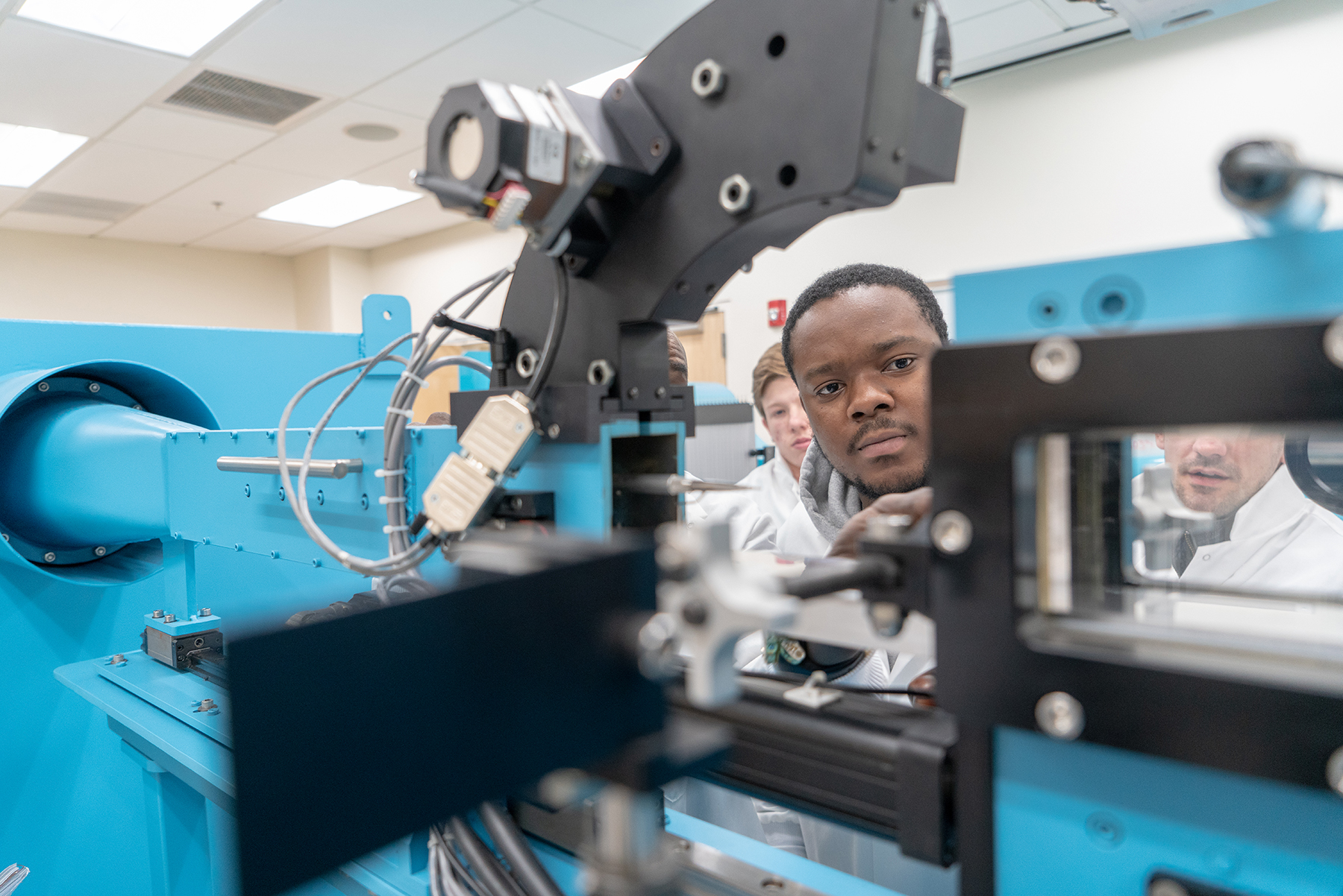
Seeking a Higher Level
Dr. Wilson came to Morgan following the extraordinary, 26-year presidency of Earl Richardson, Ed.D., now namesake of Morgan’s library, who had led MSU from a difficult period of academic and organizational stagnation to a time of growth often referred to as the Morgan Renaissance. Morgan, by then, was a well-set pillar of Baltimore City and the region, having prepared generations of students for careers in critical areas such as education, social work and civic governance and having laid the academic groundwork for many who went on to excel in fields such as medicine and the law. The University’s influence in what is now known as STEM (science, technology, engineering and mathematics) had also been growing for decades and had flourished with initiatives such as the founding of the Clarence M. Mitchell Jr. School of Engineering in 1984.
The challenge for Morgan’s new administration was how best to extend the University’s winning track record and move the institution to an even higher level of success. Dr. Wilson took that challenge head on during his second month in office, appointing a task force composed of MSU faculty, students, staff, alumni, administrators and deans, in addition to members of the local community, to create a 10-year strategic plan for the University. The plan, “Growing the Future, Leading the World: The Strategic Plan for Morgan State University, 2011–2021,” redefined the institution with new vision and mission statements and a set of core values, all supporting five quantified strategic goals.
Ten years after his inauguration, and three years after the celebration of the institution’s sesquicentennial, we bear witness to the great strides Morgan State University has made with President Wilson’s stewardship. Despite the challenges of the times, Morgan, today, is enjoying a period of unprecedented growth and advancement, a period perhaps best characterized as, simply, Morgan Momentum.
Since I’ve been employed here, Morgan has changed significantly, by increasing its research capacity, increasing its partnerships and collaborations, increasing its student recruitment and retention and increasing its building infrastructure.
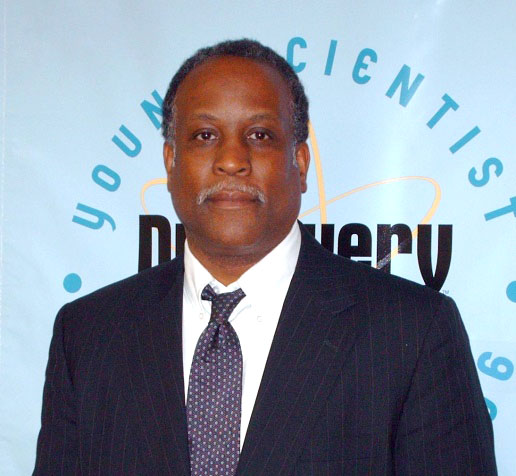
Director, MSU Center for Excellence in Science and Mathematics Education
Academic Advancement
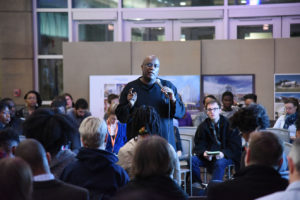 Morgan State University’s academic tree has burgeoned greatly since 2010, with the addition of 30 bachelor’s, master’s and doctoral degree programs; a dozen post-baccalaureate certificates; and a new school, the School of Global Journalism and Communication, which was established in 2013 and internationally accredited by the Accrediting Council on Education in Journalism and Mass Communications in May 2020. The University launched its first online degree program, a doctoral in Community College Leadership, in 2010. That program now stands with 14 others that have helped Morgan keep pace with the advancement of high- er education in the Digital Age.
Morgan State University’s academic tree has burgeoned greatly since 2010, with the addition of 30 bachelor’s, master’s and doctoral degree programs; a dozen post-baccalaureate certificates; and a new school, the School of Global Journalism and Communication, which was established in 2013 and internationally accredited by the Accrediting Council on Education in Journalism and Mass Communications in May 2020. The University launched its first online degree program, a doctoral in Community College Leadership, in 2010. That program now stands with 14 others that have helped Morgan keep pace with the advancement of high- er education in the Digital Age.
Morgan offers the sole degree program in Maryland in a number of key disciplines, such as Actuarial Science, Architecture and Environmental Design, Interior Design and Psychometrics, and is a standout now in science, technology, engineering and math (STEM) fields, graduating more technical degree holders than the national average and having a higher percentage of STEM-employed alumni than any other college or university in Maryland. Two recent additions to degree offerings in Morgan’s School of Computer, Mathematical and Natural Sciences promise to continue that trend: a Bachelor of Science in Cloud Computing, the only such program in the state, and a Master of Science in Advanced Computing.
The impressive academic growth of Morgan State University will accelerate in the coming years. The University signed an agreement with Salud Education, LLC, this past January, for the establishment of a College of Osteopathic Medicine on MSU’s campus. Scheduled to open in early 2023, the college will be the first new medical school at an Historically Black College or University (HBCU) in nearly 45 years and the first-ever osteopathic medical school at an HBCU.
Student Success
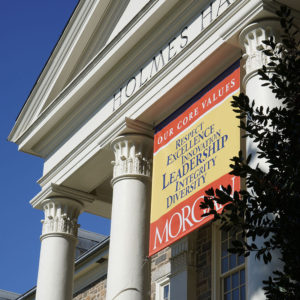 MSU’s intense focus on “Enhancing Student Success,” Goal #1 of its 2011– 2021 Strategic Plan, has yielded many positive results. Since recognizing its 50,000th graduate, Computer Science major Joseph L. Jones of Baltimore, during the University’s Fall 2016 Commencement Exercises, Morgan has conferred an additional 3,994 baccalaureates and an additional 1,307 master’s and doctoral degrees, bringing the total number of MSU graduates to more than 55,000. Key to this achievement was the innovative work the University has done to move its students from matriculation to graduation.
MSU’s intense focus on “Enhancing Student Success,” Goal #1 of its 2011– 2021 Strategic Plan, has yielded many positive results. Since recognizing its 50,000th graduate, Computer Science major Joseph L. Jones of Baltimore, during the University’s Fall 2016 Commencement Exercises, Morgan has conferred an additional 3,994 baccalaureates and an additional 1,307 master’s and doctoral degrees, bringing the total number of MSU graduates to more than 55,000. Key to this achievement was the innovative work the University has done to move its students from matriculation to graduation.
The award-winning initiatives of MSU’s Office of Student Success and Retention, part of the Division of Enrollment Management and Student Success, are major reasons why Morgan has achieved its goals for second-year retention, which has remained above 70% since the 2010– 11 academic year. Moreover, the University is also making steady progress toward its “50 x 25” goal, which is to achieve a six-year graduation rate of 50% by the year 2025. The graduation rate for the cohort of students who entered Morgan in 2014 was 46.2%, a significant improvement over the 29% rate for the students who entered in 2005, and the highest rate on record for the University.
In Spring 2020, Morgan’s student body comprised more than 7,763 scholars, a number that represented a 7.4% increase over its enrollment in 2009. Disruption by the COVID-19 pandemic caused a surprisingly small 2% dip in student enrollment in Fall 2020 compared with Fall 2019, continuing the University’s movement against the trend of steep enrollment declines at many four-year institutions of higher education across the country.
As the diversity of Morgan’s student body continues to grow, in line with the University’s Core Values, MSU’s tradition of success in advancing its original mission of providing higher education to African Americans thrives. Morgan is a leader in Maryland and the nation in producing African-American recipients of academic degrees in many key disciplines.
The enrollment, retention and graduation statistics, and high national and state rankings in degree production, are sources of pride for the University, but even more so are the countless success stories behind those numbers: the accomplishments of Morgan students who have earned recognition for their scholarship and service.

Research and Innovation
The designation of Morgan State University as the state’s Preeminent Public Urban Research University, in May 2017, reflected decades of foundational work as well as MSU’s research accomplishments over the previous seven years. In 2010, the University gained a $3.1-million share of a $129-million U.S. Department of Energy grant to Penn State University to research energy innovation. Another major milestone was reached in 2011, when MSU procured its largest research contract to date: a $28.5-million, five-year agreement with NASA in a program titled GESTAR, Goddard Earth Sciences Technology and Research.
Two years later, the University established its Division of Research and Economic Development (D-RED), which has the primary responsibility for research policy, oversight of the administration and management of grants and contracts to support faculty research activity, and oversight of responsible conduct of research education and compliance at Morgan.
The organizational change that created D-RED has yielded tremendous benefits, as the division — and its previous incarnations — have overseen more than $314 million in awarded contracts and grants. Among the many highlights: in 2014, Morgan received a $23.3-million award from the National Institutes of Health (NIH) to launch “A Student- Centered, Entrepreneurship Development” (ASCEND) Training Model to Increase Diversity in the Biomedical Research Workforce.” The competitive award was the second-largest in the University’s history and the highest to date to Morgan from the NIH.
Additional wins increased Morgan’s momentum in research in 2019: to list just a few, the NIH continued its support of ASCEND with $16.9 million in additional funding; NASA and USRA, Morgan’s lead partner in GESTAR, extended the University’s participation in that program for an additional five years, increasing the value of the contract to $40 million; and a five-year grant from the Silicon Valley-based financial technology (“fintech”) firm Ripple funded an academic partnership to advance research, technical development and innovation at MSU in blockchain, cryptocurrency and digital payments.
In December 2018, the Carnegie Classification of Institutions of Higher Education moved Morgan to an elevated classification of R2, a status reserved for doctoral universities with high research activity. The University joined only 130 other institutions nationwide — including fewer than a dozen HBCUs — that have an R2 classification.
Statistics show that Morgan generates significantly more key innovation outputs and outcomes per research dollar than state and national averages. And the University’s focus on innovation has also enhanced its campus operations, in areas ranging from course delivery to facilities construction to digital communication.
Expanded Global Footprint
Having established its Division of International Affairs in 2014, Morgan has grown from regional and national influence to be- come an institution with truly global reach during the past de- cade, more than doubling its number of international students from 2010 through 2019. The number of students engaged in study abroad has also reached a record high, and the formation of academic partnerships with universities beyond the United States for student and faculty exchange and other collaborations is rising. Among those partnerships are two recent initiatives in Africa: Master of Business Administration, Master of Science in Global Multimedia Journalism and Communications and Bachelor of Science in Entrepreneurship programs with the African University College of Communications and a five-year agreement with Nigeria’s Tertiary Education Trust Fund (TET- Fund) that will sponsor up to 50 new Ph.D. students and up to 20 postdoctoral researchers from public tertiary institutions in Nigeria for study and research at Morgan each year.
China, Kuwait and Saudi Arabia are among many other countries where Morgan began new academic collaborations that have brought large numbers of international students to the MSU campus since 2010.
Campus Facilities and Infrastructure
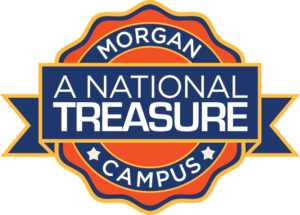 For some Morgan alumni and others long absent from the campus, the visual impact of the transformation created by more than $271 million in campus construction over the past 10 years is stunning. Among many improvements, large, modern facilities now highlight the grounds at the northern, central and southern approaches to the campus from Hillen Road, blending beautifully into the well-kept greenery of the nation’s only HBCU campus named a National Treasure by the National Trust for Historic Preservation.
For some Morgan alumni and others long absent from the campus, the visual impact of the transformation created by more than $271 million in campus construction over the past 10 years is stunning. Among many improvements, large, modern facilities now highlight the grounds at the northern, central and southern approaches to the campus from Hillen Road, blending beautifully into the well-kept greenery of the nation’s only HBCU campus named a National Treasure by the National Trust for Historic Preservation.
The impact of the campus improvements on Morgan’s mission has been just as strong. The University’s well-planned investment in its facilities and other physical infrastructure has helped enhance the quality of the education Morgan offers, grow the University’s enrollment numbers and increase the competency and competitiveness of its students. In addition, Morgan’s campus is attracting new faculty, facilitating partnerships with other organizations and is growing opportunities to conduct research that benefits community and economic development in the city of Baltimore and the surrounding region.
A few highlights of Morgan’s physical improvements since July 2010 follow:
- Martin D. Jenkins Hall, Behavioral and Social Sciences Center ($79 million) and the Morgan Business Center ( $81 million)
- Legacy Bridge, linking the University’s Main Campus and West Campus.
- Campus information technology infrastructure upgrade ($25 million)
- Calvin and Tina Tyler Hall Student Services Building ($88 million)
- Northwood Commons renovation/New Police and Public Safety Building ($50 million)
- W.A.C. Hughes Memorial Stadium upgrades ($2.5 million)
- Health and Human Services Building ($156 million)*
- Thurgood Marshall Complex Residence Hall ($115 million)*
*Construction now underway
(When) I was hired in January 2008, I was thrilled…I got recruited to serve as the dean of Morgan’s School of Architecture and Planning. I imagined a future University with an extensive research footprint, especially in the built environment disciplines. That vision is certainly realized. I believe the campus image has significantly change how the public looks at us.

Dean, MSU School of Architecture and Planning

Fundraising and Finance
Monetary support of the institution’s mission has been a central part of Morgan State University’s success story since its founding as Centenary Biblical Institute in 1867. Morgan’s Sesquicentennial Anniversary Campaign, launched in July 2010, is another great chapter in the University’s saga. The University’s Institutional Advancement team, Research and Development staff, faculty members and others collaborated successfully to raise $254 million in public and private funds — $4 million above the University’s goal and among the largest amounts ever raised for an HBCU. The goal of the campaign was to raise money to support every facet of life at the institution, from underwriting student financial aid and funding new academic initiatives to growing community engagement programs and strengthening the University endowment. More than 13,000 individuals —alumni, parents, faculty and students— contributed to the record-setting sum, among them, nationally known philanthropists Calvin and Tina Tyler, whose $5-million gift to their endowed scholarship fund in 2016 was the largest individual donation in the school’s history at the time, and President Wilson, who has contributed more than $158,000 to the Five Dollar Scholarship Fund he launched in 2010. The value of that fund is now more than $1 million, on its way to the initiative’s $5-million goal.
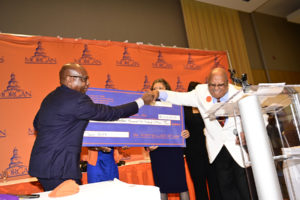 Moreover, since the conclusion of the Anniversary Campaign in December 2018, fundraising for Morgan has continued apace. The University raised $13.7 million during the 2019 fiscal year, an amount that significantly exceeds the annual total raised in the past.
Moreover, since the conclusion of the Anniversary Campaign in December 2018, fundraising for Morgan has continued apace. The University raised $13.7 million during the 2019 fiscal year, an amount that significantly exceeds the annual total raised in the past.
Skillful management of the University’s finances is another pillar supporting the institution’s decade-long success, and that proficiency has gained recognition from top authorities. The annual credit rating reviews conducted by Moody’s and Standard & Poor’s in the fall of 2018 affirmed the companies’ ratings of A1 and A+, respectively, with a stable outlook. In addition, Morgan received an unmodified opinion of the University’s audited financial statement from SB & Company for the eighth consecutive year. The University’s strong credit rating and shrewd financial acumen have enhanced the Morgan brand and have been a major factor in the University’s historic fundraising.
Morgan’s financial strength also supports the region. An independent report compiled at the request of President Wilson quantified a benefit long known by MSU supporters. “Morgan is a major economic engine for the city and state, annually producing more than $1 billion in statewide economic impact, supporting 6,900 jobs and generating $53 million in state tax revenues,” stated in the FY21 Economic Impact Update, a revision of the original report, compiled in 2018 and titled “Excellence in Education, Research, and Public Service: The Economic and Social Impact of Morgan State University.”
The Road Ahead
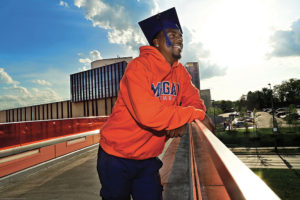 Morgan’s success in implementing initiatives to meet the goals of its 2011–21 Strategic Plan surprised even the most faithful of the University’s believers. By December 2018, so much progress had been made that President Wilson’s administration announced higher quantifiable targets for the institution through 2023, in areas including student housing, student enrollment, student diversity, graduation and retention rates, study abroad, research, capital improvements, capital additions, strategic partnerships, community engagement and athletics.
Morgan’s success in implementing initiatives to meet the goals of its 2011–21 Strategic Plan surprised even the most faithful of the University’s believers. By December 2018, so much progress had been made that President Wilson’s administration announced higher quantifiable targets for the institution through 2023, in areas including student housing, student enrollment, student diversity, graduation and retention rates, study abroad, research, capital improvements, capital additions, strategic partnerships, community engagement and athletics.
The road ahead will not be easy for Morgan or for HBCUs in general, however. Recovery from the personal and economic casualties of the COVID-19 pandemic, and closing the racial and political divisions long prevalent in the nation, will be challenging. With higher education itself in flux, much change will be required.
But challenge and change are no strangers to Morgan. With strong leadership and with the unbreakable commitment to mission that has permeated the entire institution throughout its history, the University will continue to thrive. The numbers prove that Morgan State University is stronger than ever, a fact that bodes well for the institution’s success as it envisions Growing the Future, Leading the World in the decade to come.
Pandemic Planning and Response
The decision by Morgan State University to instruct its students remotely during the Fall 2020 semester came after months of thoughtful deliberation, careful communication and meticulous planning to meet the evolving challenges of COVID-19.
Since the beginning of the pandemic, Morgan has led most institutions of higher education in the region with its response to the coronavirus: reviewing and updating its Campus- Wide Pandemic Disease Preparation Plan in late February 2020 to address the new virus, for example, and appointing administrators, faculty, staff and student leaders to a Campus Reopening and Readiness/Preparedness Committee in early May. The University announced in June that fall semester courses would include a mix of in-person and remotely instructed classes. However, as MSU President David K. Wilson stated in an email message delivered to the Morgan family on Aug. 11, “…even the best laid plans must be revisited when all of the indicators show the COVID-19 virus increasing in spread in our city, state and nation.” The pivot was made to online-only instruction, and on-campus living was reduced significantly, while most of the buildings on campus remained closed.
Other decisions announced in the President’s August communication included fee reduction for students to account for unused room and board; increased institutional aid to assist students who are financially challenged because of the pandemic; and special, on-campus housing arrangements for 300 students who have extenuating circumstances that do not allow them to reside elsewhere.
Plans for the Spring 2020 semester will be revised as required to account for new data on the spread of COVID-19.

